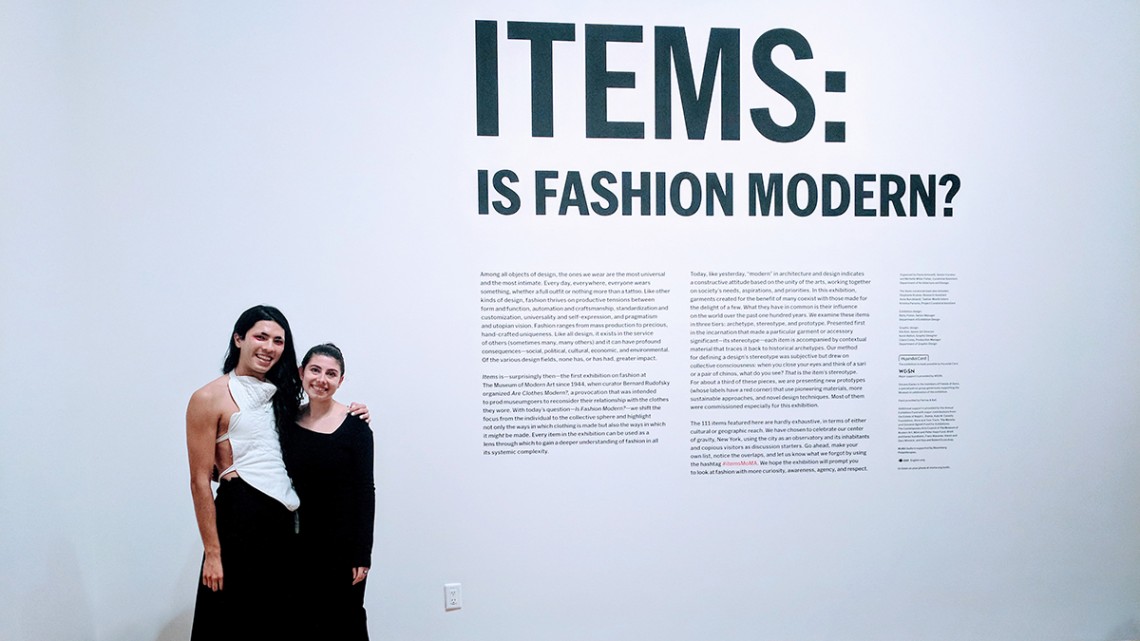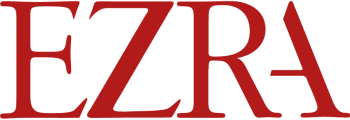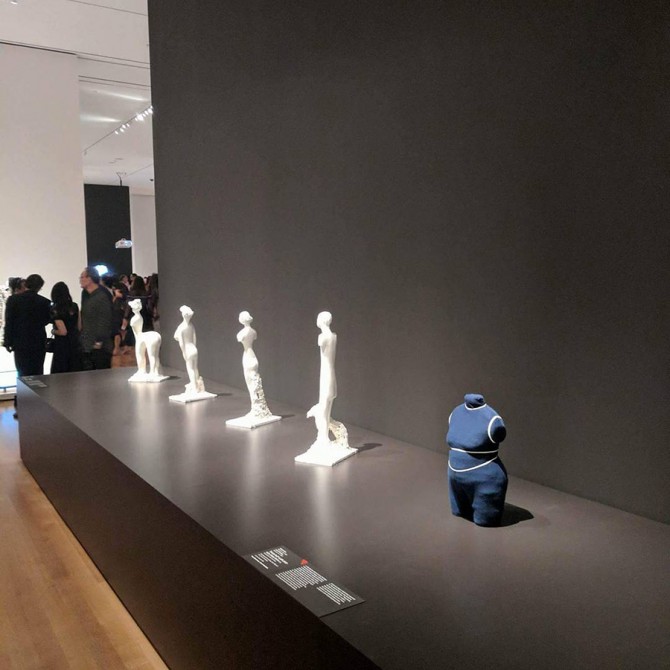
Brandon Wen ’15, left, and Laura Zwanziger ’15 at the opening of the “Items: Is Fashion Modern?” exhibition at the Museum of Modern Art.
Fashion alumni project: from MVR to MoMA
By Stephen D'Angelo
As sophomores, Brandon Wen ’15 and Laura Zwanziger ’15 designed a plus-size dress form for an assignment in their Product Development course. Now their class project is on display at the Museum of Modern Art in New York City.
Wen and Zwanziger’s plus-size dress form, “Tolula,” is featured in “Items: Is Fashion Modern?” at MoMA until Jan. 28. The exhibition, the museum’s first fashion-focused show since 1944, highlights the present, past and future of fashion trends, featuring 111 items of clothing and accessories that have had a strong impact on the world in the 20th and 21st centuries.
“With the name Tolula, it was this funny sort of spontaneous decision to name her that – personal and in no way scientific or research-based,” said Wen. “Then it was there on the plaque in the MoMA and it was like, ‘Wow, can you believe that this whole thing that was just an idea we had, not even intending it to be more than a project for a class, blew up in such a way?’”
Zwanziger said, “We were originally contacted back in February, and both of us thought there must be another ‘MoMA’ or kept thinking that it would all fall through or was too good to be true, and then when we went to the opening together it was so exciting to see her there on display with so many other fashion artifacts.”
The 2013 class assignment tasked students to create half-scale samples of a fictional product line for an underrepresented demographic group. Wen and Zwanziger decided to work with a plus-size design, inspired by the elegance and curves of plus-size models in a nude drawing class. Early on in the project, they faced a barrier: There were few plus-size mannequins to work with, and the few available “full-figured” ones were crudely scaled-up versions of thinner women, as opposed to shapes and contours for real plus-size forms.
The solution was to create their own half-scale mannequin, which allows designers to develop prototype garment patterns that later can be replicated at full scale, through a combination of creative design and significant research. Wen and Zwanziger analyzed thousands of 3-D body scans of women to define a prototype body size and shape.
They then matched it to a single scan of a pear-shaped, size 24 woman from the FSAD department’s 3-D body scanner and used it to develop a pattern for the shape and contours of their mannequin. Next they used the department’s laser cutter to slice half-inch-thick pieces of foam and stacked and glued the layers to create Tolula.
New York Magazine, Cosmopolitan, Seventeen Magazine, Huffington Post and The Wall Street Journal all published articles about their design. In February, MoMA curators emailed Wen and Zwanziger to ask if they could borrow Tolula.
“A lot of the pieces I think in the exhibition were very iconic moments in fashion, in recent history, that defined culture or defined fashion for this or that reason,” said Wen. “I think Tolula [and] a handful of other things were instead made or done to question how things are done, or really push this sort of idea of modernity and what we should be thinking about.”
According to Wen and Zwanziger, in recent years, established companies have moved into the plus-size market but limit women’s options by upscaling a smaller cut into a larger one instead of looking at different body types. This is a major issue in plus-size design as different shapes become differentiated at larger sizes, such as when a size 24 can have a very different bust size depending on body shape.
“There was a recent article in The Wall Street Journal about how a lot of smaller startups are having a lot of success designing for the plus-size market because it has been so underdeveloped in the industry,” Zwanziger said, noting that returns of custom fit and shape-based clothes by plus-size buyers online tend to be much lower than regular returns. “We are seeing a more healthy shift in the right direction, but these trends aren’t necessarily changing the ideal of beauty, which is the biggest influence in the fashion industry.”
“Clothing and fashion is ultimately meant to be fun and exciting,” she said. “In terms of a more body positive movement, having products available that are well-designed is what is going to push the industry forward in terms of making fashion and the dress relevant.”
Stephen D'Angelo is assistant director of communications for the College of Human Ecology.
Media Contact
Get Cornell news delivered right to your inbox.
Subscribe


